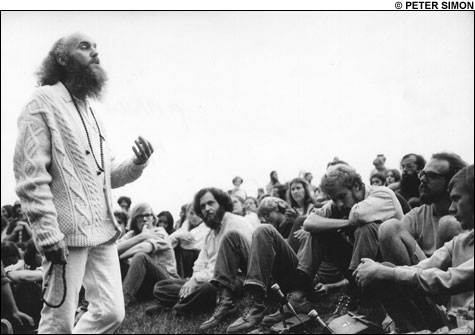
SPREADING THE JOY: Baba Ram Dass (Richard Alpert) worked (and played) with Timothy Leary at Harvard and became the spiritual leader of the psychedelic movement. |
Brave new world
Long before Leary, a number of prominent thinkers and scientists were dropping acid, eating mushrooms, and changing some long-held notions about mind and consciousness. Ironically, the first instance of psychedelic research in America also began at Harvard, this one in the late 19th century. Philosopher and psychologist William James, in an attempt to understand mystical states of consciousness, experimented with nitrous oxide, which he believed “simulates the mystical consciousness in an extraordinary degree.” In 1882 and 1889, James published a number of articles, both anonymously (in The Atlantic Monthly) and under his own name.
But psychedelics weren’t going to embed themselves into the psychic landscape on their own. The first real American psychedelic milestone occurred in 1953, when Aldous Huxley was given mescaline by Humphrey Osmond, a scientist with an interest in LSD and consciousness. Huxley wrote about his experience in the now classic work The Doors of Perception, which he titled after a quote from the visionary poet William Blake. Few could have foreseen that this slight little tome about an intellectual’s illumination and personal psychedelic journey would have shot such a powerful solar flare out into the cultural atmosphere.
Not long after Huxley’s publication, other scholars and writers started taking psilocybin, writing papers, and performing many other experiments. The late ‘50s and early ‘60s saw an explosion of above-ground psychedelic research. For the most part, even those affiliated with such places as Harvard were not afraid to discuss their own experiences with these drugs.
Leary’s Harvard stint and the criminalization of psychedelics profoundly affected serious researchers’ and others’ ability to talk candidly. Nevertheless, this candor helped get funding for research at places like Harvard. Halpern is intensely private, which in his case helps both the science and the institutions.
On the other hand, Doblin’s work has been shaped by his experiences, and while MAPS as an organization wants the same thing Halpern does, which is to assess the medicinal value of these drugs, Doblin’s own vision is further reaching. He envisions a day when there are psychedelic clinics and, after someone participates in a workshop, or better yet, passes a “test” that demonstrates they can safely drive these drugs around the highways and side streets of their consciousness, as Doblin says, “They can get a license that will allow them to use psychedelics privately.”
More than 40 years ago, some psychedelic investigators imagined LSD playgrounds, Disneyworlds of drugs where people could drop acid and frolic in a land of cellophane flowers and newspaper taxis. Doblin’s vision is more realistic, but the idea that psychedelics could one day become a regular part of our culture is not so different. Neither Halpern nor Doblin wants to try to levitate the Pentagon, but I imagine that, of the two of them, Doblin wouldn’t mind trying.
Halpern seems content to work in his lab, although beyond his field work with Native Americans in his peyote study, he has spent time on the firing line. Between 2002 and 2005, Halpern was a ranger at Burning Man for something called Sanctuary, a kind of official safe house that provided psychotherapy and support for people who were having a rough time with a drug trip.